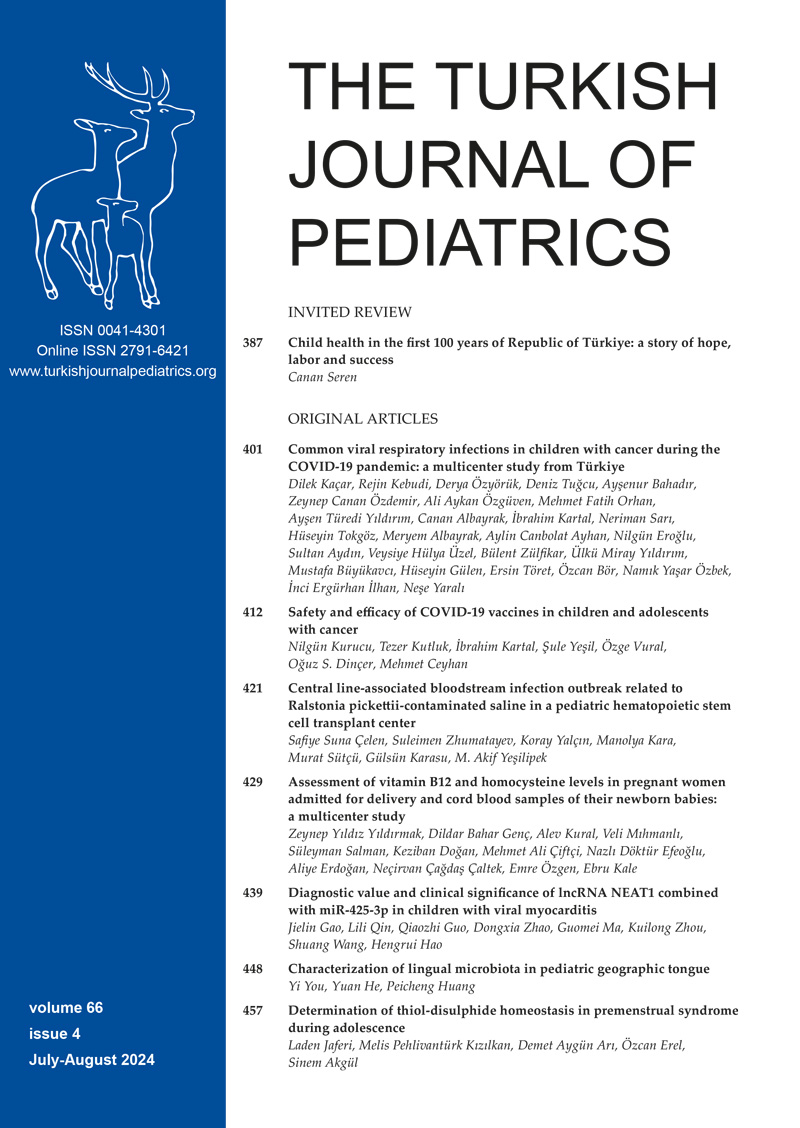Video Abstract
Abstract
Background. Premenstrual syndrome (PMS) characterized by cyclic symptoms during the luteal phase of the menstrual cycle, presents an uncertain etiology in adolescents involving hormonal fluctuations and serotonin-related neurotransmitters with a limited existing literature on the impact of oxidative stress. This study aimed to explore the potential association between PMS and oxidative stress in adolescents.
Methods. In a cross-sectional study conducted at a university hospital, involving 45 adolescent girls aged 12 to 18, participants were categorized based on the presence or absence of PMS using the cut-off point of 110 on the PMS Scale developed by Gençdoğan. Oxidative stress was assessed through dynamic thiol-disulfide homeostasis. The shift from the balance towards disulfide form is associated with oxidative stress, whereas towards thiol it shows a greater antioxidant capacity.
Results. Thirty out of the forty-five participants were found to have PMS with a mean age of 15.5 years. The PMS group demonstrated a significant increase in antioxidant markers, specifically elevated native (631.6±57.55 vs 598.2±41.08, p=0.048) and total thiol levels (675.15±3.4 vs 639.3±44.9, p=0.031). Despite a significant increase in thiol, thiol to disulfide ratio was not found to be significant (p=0.849).
Conclusion. Contradictory to other studies in adults, we have demonstrated an increase in the antioxidant markers in adolescents with PMS. Elevated antioxidant status in adolescents with PMS may be an adaptive response to acute cyclic inflammation in the adolescent period, which might decrease with the progression of age. Further research is needed to investigate the complex interaction between oxidative stress and PMS across different age groups.
Keywords: premenstrual syndrome, thiol-disulphide homeostasis, adolescence, oxidative stress
References
- Takeda T. Premenstrual disorders: Premenstrual syndrome and premenstrual dysphoric disorder. J Obstet Gynaecol Res 2023; 49: 510-518. https://doi.org/10.1111/jog.15484
- Siminiuc R, Ţurcanu D. Impact of nutritional diet therapy on premenstrual syndrome. Front Nutr 2023; 10: 1079417. https://doi.org/10.3389/fnut.2023.1079417
- Granda D, Szmidt MK, Kaluza J. Is Premenstrual syndrome associated with inflammation, oxidative stress and antioxidant status? A systematic review of case-control and cross-sectional studies. Antioxidants (Basel) 2021; 10: 604. https://doi.org/10.3390/antiox10040604
- Dandekar A, Mendez R, Zhang K. Cross talk between ER stress, oxidative stress, and inflammation in health and disease. Methods Mol Biol 2015; 1292: 205-214. https://doi.org/10.1007/978-1-4939-2522-3_15
- Erel Ö, Erdoğan S. Thiol-disulfide homeostasis: an integrated approach with biochemical and clinical aspects. Turk J Med Sci 2020; 50: 1728-1738. https://doi.org/10.3906/sag-2003-64
- Sultana A, Rahman K, Heyat MBB, Sumbul, Akhtar F, Muaad AY. Role of inflammation, oxidative stress, and mitochondrial changes in premenstrual psychosomatic behavioral symptoms with anti-inflammatory, antioxidant herbs, and nutritional supplements. Oxid Med Cell Longev 2022; 2022: 3599246. https://doi.org/10.1155/2022/3599246
- Bahrami A, Bahrami-Taghanaki H, Khorasanchi Z, et al. Menstrual problems in adolescence: relationship to serum vitamins A and E, and systemic inflammation. Arch Gynecol Obstet 2020; 301: 189-197. https://doi.org/10.1007/s00404-019-05343-1
- Bahrami A, Gonoodi K, Khayyatzadeh SS, et al. The association of trace elements with premenstrual syndrome, dysmenorrhea and irritable bowel syndrome in adolescents. Eur J Obstet Gynecol Reprod Biol 2019; 233: 114-119. https://doi.org/10.1016/j.ejogrb.2018.12.017
- Itriyeva K. The normal menstrual cycle. Curr Probl Pediatr Adolesc Health Care 2022; 52: 101183. https://doi.org/10.1016/j.cppeds.2022.101183
- Gençdoğan B. Premenstruel sendrom için yeni bir ölçek. Türkiye'de Psikiyatri Derg 2006; 8: 81-87.
- Erel O, Neselioglu S. A novel and automated assay for thiol/disulphide homeostasis. Clin Biochem 2014; 47: 326-332. https://doi.org/10.1016/j.clinbiochem.2014.09.026
- Drejza MA, Rylewicz K, Majcherek E, et al. Markers of oxidative stress in obstetrics and gynaecology-a systematic literature review. Antioxidants (Basel) 2022; 11: 1477. https://doi.org/10.3390/antiox11081477
- Foster R, Vaisberg M, Bachi ALL, et al. Premenstrual syndrome, inflammatory status, and mood states in soccer players. Neuroimmunomodulation 2019; 26: 1-6. https://doi.org/10.1159/000494559
- Bertone-Johnson ER, Ronnenberg AG, Houghton SC, et al. Association of inflammation markers with menstrual symptom severity and premenstrual syndrome in young women. Hum Reprod 2014; 29: 1987-1994. https://doi.org/10.1093/humrep/deu170
- Incebiyik A, Camuzcuoglu A, Hilali NG, et al. Serum oxidative stress, visfatin and apelin in healthy women and those with premenstrual syndrome. J Obstet Gynaecol 2015; 35: 188-192. https://doi.org/10.3109/01443615.2014.948399
- Duvan CI, Cumaoglu A, Turhan NO, Karasu C, Kafali H. Oxidant/antioxidant status in premenstrual syndrome. Arch Gynecol Obstet 2011; 283: 299-304. https://doi.org/10.1007/s00404-009-1347-y
- Fathizadeh S, Amani R, Haghighizadeh MH, Hormozi R. Comparison of serum zinc concentrations and body antioxidant status between young women with premenstrual syndrome and normal controls: a case-control study. Int J Reprod Biomed 2016; 14: 699-704.
- Ertürk C, Altay MA, Büyükdoğan H, Çalışkan G, Erel Ö. Thiol/disulfide homeostasis as a novel indicator of oxidative stress during the treatment process of patients with septic arthritis. Jt Dis Relat Surg 2020; 31: 502-508. https://doi.org/10.5606/ehc.2020.71982
- Boss GR, Seegmiller JE. Age-related physiological changes and their clinical significance. West J Med 1981; 135: 434-440.
- Michaud PA, Fombonne E. Common mental health problems. BMJ 2005; 330: 835-838. https://doi.org/10.1136/bmj.330.7495.835
- Eckert MA, Harris KC, Lang H, et al. Translational and interdisciplinary insights into presbyacusis: a multidimensional disease. Hear Res 2021; 402: 108109. https://doi.org/10.1016/j.heares.2020.108109
- Aleksandrova K, Koelman L, Rodrigues CE. Dietary patterns and biomarkers of oxidative stress and inflammation: a systematic review of observational and intervention studies. Redox Biol 2021; 42: 101869. https://doi.org/10.1016/j.redox.2021.101869
- Powers SK, Deminice R, Ozdemir M, Yoshihara T, Bomkamp MP, Hyatt H. Exercise-induced oxidative stress: Friend or foe? J Sport Health Sci 2020; 9: 415-425. https://doi.org/10.1016/j.jshs.2020.04.001
- Sharma V, Mehdi MM. Oxidative stress, inflammation and hormesis: the role of dietary and lifestyle modifications on aging. Neurochem Int 2023; 164: 105490. https://doi.org/10.1016/j.neuint.2023.105490
Copyright and license
Copyright © 2024 The Author(s). This is an open access article distributed under the Creative Commons Attribution License (CC BY), which permits unrestricted use, distribution, and reproduction in any medium or format, provided the original work is properly cited.















